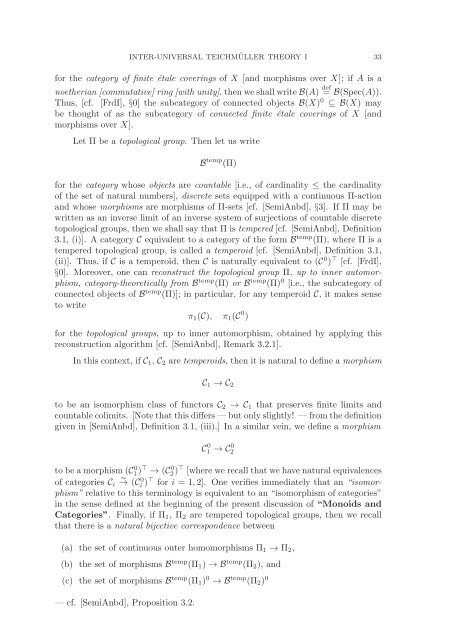Inter-universal Teichmuller Theory I: Construction of Hodge Theaters
Inter-universal Teichmuller Theory I: Construction of Hodge Theaters
Inter-universal Teichmuller Theory I: Construction of Hodge Theaters
Create successful ePaper yourself
Turn your PDF publications into a flip-book with our unique Google optimized e-Paper software.
INTER-UNIVERSAL TEICHMÜLLER THEORY I 33<br />
for the category <strong>of</strong> finite étale coverings <strong>of</strong> X [and morphisms over X]; if A is a<br />
noetherian [commutative] ring [with unity], then we shall write B(A) def<br />
= B(Spec(A)).<br />
Thus, [cf. [FrdI], §0] the subcategory <strong>of</strong> connected objects B(X) 0 ⊆B(X) may<br />
be thought <strong>of</strong> as the subcategory <strong>of</strong> connected finite étale coverings <strong>of</strong> X [and<br />
morphisms over X].<br />
Let Π be a topological group. Then let us write<br />
B temp (Π)<br />
for the category whose objects are countable [i.e., <strong>of</strong> cardinality ≤ the cardinality<br />
<strong>of</strong> the set <strong>of</strong> natural numbers], discrete sets equipped with a continuous Π-action<br />
and whose morphisms are morphisms <strong>of</strong> Π-sets [cf. [SemiAnbd], §3]. If Π may be<br />
written as an inverse limit <strong>of</strong> an inverse system <strong>of</strong> surjections <strong>of</strong> countable discrete<br />
topological groups, then we shall say that Π is tempered [cf. [SemiAnbd], Definition<br />
3.1, (i)]. A category C equivalent to a category <strong>of</strong> the form B temp (Π), where Π is a<br />
tempered topological group, is called a temperoid [cf. [SemiAnbd], Definition 3.1,<br />
(ii)]. Thus, if C is a temperoid, then C is naturally equivalent to (C 0 ) ⊤ [cf. [FrdI],<br />
§0]. Moreover, one can reconstruct the topological group Π, up to inner automorphism,<br />
category-theoretically from B temp (Π) or B temp (Π) 0 [i.e., the subcategory <strong>of</strong><br />
connected objects <strong>of</strong> B temp (Π)]; in particular, for any temperoid C, it makes sense<br />
to write<br />
π 1 (C), π 1 (C 0 )<br />
for the topological groups, up to inner automorphism, obtained by applying this<br />
reconstruction algorithm [cf. [SemiAnbd], Remark 3.2.1].<br />
In this context, if C 1 , C 2 are temperoids, then it is natural to define a morphism<br />
C 1 →C 2<br />
to be an isomorphism class <strong>of</strong> functors C 2 →C 1 that preserves finite limits and<br />
countable colimits. [Note that this differs — but only slightly! — from the definition<br />
given in [SemiAnbd], Definition 3.1, (iii).] In a similar vein, we define a morphism<br />
C 0 1 →C 0 2<br />
to be a morphism (C1) 0 ⊤ → (C2) 0 ⊤ [where we recall that we have natural equivalences<br />
∼<br />
<strong>of</strong> categories C i → (C<br />
0<br />
i ) ⊤ for i =1, 2]. One verifies immediately that an “isomorphism”<br />
relative to this terminology is equivalent to an “isomorphism <strong>of</strong> categories”<br />
in the sense defined at the beginning <strong>of</strong> the present discussion <strong>of</strong> “Monoids and<br />
Categories”. Finally, if Π 1 ,Π 2 are tempered topological groups, then we recall<br />
that there is a natural bijective correspondence between<br />
(a) the set <strong>of</strong> continuous outer homomorphisms Π 1 → Π 2 ,<br />
(b) the set <strong>of</strong> morphisms B temp (Π 1 ) →B temp (Π 2 ), and<br />
(c) the set <strong>of</strong> morphisms B temp (Π 1 ) 0 →B temp (Π 2 ) 0<br />
— cf. [SemiAnbd], Proposition 3.2.
















